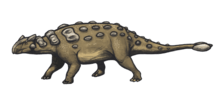Tsagantegia
| Tsagantegia Temporal range: Late Cretaceous, 90 Ma | |
|---|---|
| Scientific classification | |
| Kingdom: | Animalia |
| Phylum: | Chordata |
| Clade: | Dinosauria |
| Order: | †Ornithischia |
| Family: | †Ankylosauridae |
| Subfamily: | †Ankylosaurinae |
| Genus: | †Tsagantegia Tumanova, 1993 |
| Species: | †T. longicranialis |
| Binomial name | |
| Tsagantegia longicranialis Tumanova, 1993 | |
Tsagantegia (/ˌsɑːɡɑːnˈteɪɡiə/; meaning "of Tsagan-Teg"; Tumanova, 1993) is a genus of medium-sized ankylosaurid dinosaur from the Upper Cretaceous Mongolia, during the Cenomanian stage.
The holotype specimen (GI SPS N 700/17), a complete skull, was recovered from the Bayan Shireh Formation (Cenomanian-Santonian), at the Tsagan-Teg ("White Mountain") locality, Dzun-Bayan, in the southeastern Gobi Desert, Mongolia. The genus is monotypic, including only the type species, T. longicranialis.[1]
Description
The skull measures 30 centimetres (12 in) in length, with a maximum width of 25 centimetres (9.8 in). Vickaryous et al. (2004)[2] note that "Unlike other ankylosaurs, in Tsagantegia the cranial ornamentation is not subdivided into a mosaic of polygons but is amorphous." The quadratojugal and squamosal bosses are poorly developed, in contrast with other ankylosaurs. The skull was long and flat, smooth and bearing small horns.
Phylogenetics
In their cladistic analysis of the Ankylosauria, Vickaryous et al. (2004) placed Tsagantegia at the base of the Ankylosauridae, as the sister group to all other ankylosaurids.[2]
See also
References
- ↑ Tumanova, T. A. 1993. A new armored dinosaur from southeastern Gobi. Paleontological Journal 27(2):119-125
- 1 2 Vickaryous, Maryanska, and Weishampel 2004. Chapter Seventeen: Ankylosauria. in The Dinosauria (2nd edition), Weishampel, D. B., Dodson, P., and Osmólska, H., editors. University of California Press.

